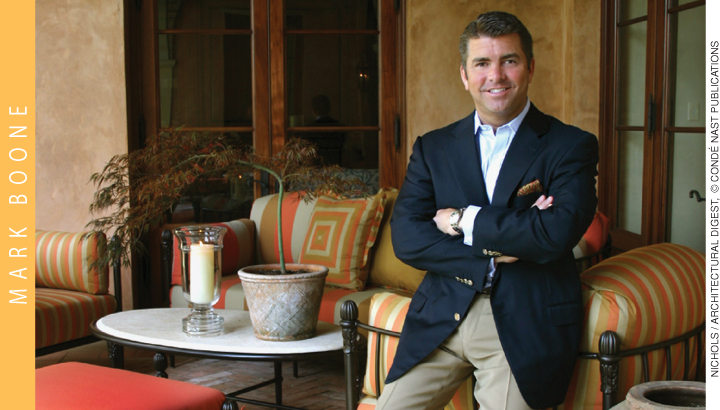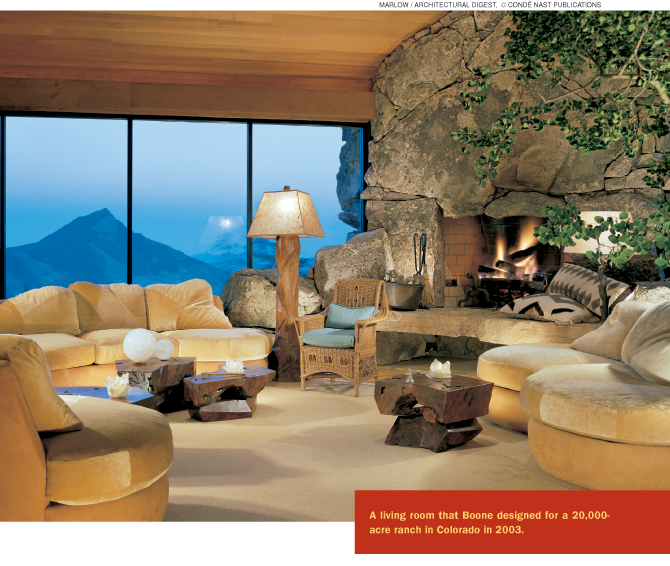 |
|
 |
||
|
An eye for design by SHERRY BITHELL
Boone began his professional journey at Virginia Tech. Although he entered as a marketing major, he soon switched to interior design. "I found that I wasn't following my true calling," he explains. "I definitely wanted to run a business, yet my passion was really for design." After beginning the design curriculum, Boone also continued taking courses in the business curriculum. Post-graduation, "I packed up my giant black portfolio and went to Washington, D.C., to search for a job," Boone says. "It was summer and it was sweltering and I was beating the pavement, interviewing with large architectural and design firms." While visiting one prospect, he had a chance meeting with the vice president of renowned furnishings company Baker Knapp and Tubbs, who happened to be there for the day. "He took an impromptu glance through my portfolio and said, 'How would you like to work in Chicago?'" In a snap, Boone went from the classroom to his own office. "It was a pretty exciting journey for a boy from Roanoke. Suddenly, I was enjoying an office view of the Chicago River, a 40th floor apartment, and traveling all over the country to work with Baker's showrooms." Yet it turned out to be too much of a good thing. Boone was sometimes traveling three weeks out of the month and didn't have time to make friends or even really settle in Chicago. "It was a bittersweet situation," Boone says, "and I ended up quitting my job. When I called my mother to say 'I just quit this dream job and I'm moving to L.A.,' you could hear the phone drop to the floor." Boone chose Los Angeles because he'd made a business trip there in February--an escape from the chill of Chicago. "Los Angeles in February smells of night-blooming jasmine and mock orange blossom. Chicago, well, doesn't. I thought it was amazing: the energy, the weather--and the weather." Back to beating the pavement, Boone visited the Pacific Design Center to see the showroom of acclaimed designer Mimi London, whom he'd read about in numerous design magazines and even in a textbook at Virginia Tech. And he was shocked by what he found. "It was a mess--the furniture was wet, things were out of place, and there was a distressed-looking woman on the phone." He later learned that the sprinkler system had gone off and damaged the showroom. At the time, thinking that he could help, he asked the woman where the manager was. "She said that he was out. I said, 'I'm Mark Boone, who might you be?' She responded, 'I'm Mimi London.' I literally shrank; she just laughed." Impressed by his bravado or his sheer honesty, or perhaps both, London invited Boone for a drink and then hired him on the spot without even looking at his portfolio. |
 |
|
That fateful day nearly 20 years ago launched Boone's remarkable partnership with London, whom he calls "a trailblazer kind of person--a giant in the industry," at Mimi London Inc., which is the division of the company that designs and manufactures furniture. "I was given the opportunity to create new designs," Boone says. "It's very exiting to have an idea on paper actually being produced and subsequently sold." The company's sister, London Boone Inc., is the celebrated interior design division, which works with private design clients, developing custom furniture to their specific needs--it's very much like a couture design business, Boone explains. A unique aspect of the firm is that all furniture is handmade, some using reclaimed wood--logs or tree trunks that are fallen or dead-standing. This is but one facet of the overall design philosophy for London Boone Inc., which is to "create powerful, organically inspired, luxury-driven design for individual clients," Boone says, citing a recent project in La Jolla, Calif., where he designed nearly every piece of furniture in the house. "The result was a strong, sculptural, organic, and comfortable type of house, not slick or off-putting, and design-appropriate to its beachfront locale." Boone's roots in the basics of design can be traced back to "several professors and classes" at Virginia Tech, he says. Faculty Emerita Jeanette Bowker, who taught History of Interiors, "really inspired me to pursue a career in design--she confirmed my aspirations." Faculty Emeritus Bob Parsons taught a furniture design class that was "a nuts and bolts kind of class, but they're the same nuts and bolts I still use every day." His appreciation of his education keeps Boone coming back--this spring, he will speak to Tech design students for the third consecutive year. "What I'm promoting is how creative and exciting and rewarding this end of the business can be. I want to inspire the students." Boone isn't all talk, though. Not only does he provide funds for program enhancement, but each year, he also sponsors the Mark Boone Residential Design Studio, where he works one-on-one with students as part of a design competition. At the end of the semester, he reviews their projects and awards money for first, second, and third place. "I see great work coming out of them--it's humbling to see how advanced students are today from when I was there," he says. Yet he also has a strong message to deliver. "Today, there is too much reliance on computers to do design work. I always stress that you should never lose the magic of pencil to paper. When you're reliant only on computers, you tend to lose some of the soul of what you're attempting."Mentoring aside, Boone is currently working on expanding the firm's six showrooms across the country, for which he also custom designs furniture. His firm takes on a limited number of design projects each year to remain intimately involved with each one it accepts. "I only take projects that really make sense for both the client and me. It's like going on a semi-blind date," Boone elaborates. "The client knows something about your work, but you know nothing about them, so you have to see if the chemistry is there. You're going to be closely involved for at least two years and hopefully friends forever, so I appreciate the luxury of choice. I work with lovely people." Boone was his own client when he bought his first home, a 1920s English cottage-style house in Los Angeles. When the house was finished, it graced the cover of Architectural Digest's "Designer's Own Home" issue in September 2002--a childhood dream realized. His designs continue to be featured in the magazine. From the basement to Beverly Hills--that's quite a career arc. |
|
|
|
|||